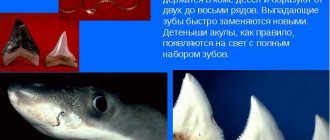Ecology
Watch the video if you are too lazy to read
Watch the video if you are too lazy to read
The animal world may seem full of all sorts of horrors, although, of course, many of the scary creatures may be quite far from us, or, fortunately, we may not even be aware of their existence. But we invite the most curious to learn about which animals’ mouths are scary to look into because of their threatening teeth. With all this, these animals can look very harmless until... they open their jaws.
Amazing narwhal tooth
There are many amazing teeth in the animal world. But we will only talk about the largest tooth among modern representatives of the fauna.
The first place in the size of teeth, or rather, just one tooth, is occupied by a marine mammal of the cetacean family, narwhal. This inhabitant of the northern waters of the Arctic and Atlantic oceans is proudly called the sea unicorn. These whales reach impressive sizes - up to 4 meters in length, and the male weighs up to 1.5 tons.
Interestingly, they only have two teeth. At the same time, their left one develops into a spirally twisted tusk up to 3 meters long and weighing 10 kilograms, while the right one is underdeveloped. The purpose of this massive device still raises many questions among zoologists today. This is not a weapon of defense or attack, it is not used to break through ice. It is assumed that this is the sensitive organ of the narwhal - after all, it is penetrated by many tubes, inside of which there are nerve endings.
4) Saw teeth of a voracious glowing shark
Imagine that you are in the dark salty depths of the sea, where you accidentally fought off a group of divers, and there is nothing around but pitch darkness and dead silence. It is in these conditions that deep-sea glowing sharks live, which appear only after sunset and swim in pitch darkness in search of prey. These fish reach only 5 centimeters in length, but have the largest teeth relative to their body size.
Due to the fact that glowing sharks cannot boast of large body sizes, they have learned to attack large fish and animals, biting off pieces of meat from them and immediately disappearing. In English the name of this shark is “cookie cutter”
translates as
“cookie cutter
,” which is quite understandable, knowing about the vile habits of this predator. The victims of sharks - whales, large fish, dolphins - do not die, but are only left with wounds that gradually heal, leaving scars. Cases of attacks on humans have also been recorded.
The evolution of our teeth
The teeth of our ancestors, who lived 100 thousand years ago, were twice as large as the average teeth of a modern person. This was explained by biological necessity - rough plant foods and raw meat required just such a chewing apparatus.
Over time, human teeth decreased, according to anthropologists' calculations, by 1% every thousand years. In addition, they not only became smaller, but also changed their purpose. Our largest tooth is the first molar on the upper jaw. The canines have lost their function of holding food and have also become smaller. But not all people grow third molars (wisdom teeth).
Which of the animals and insects bites the most?
There are many “biting” beetles. Here, for example, is the stag beetle, which lives in deciduous forests, oak groves, forest-steppe in Ukraine, Crimea, and Moldova. Males have large branching “horns” on their heads, slightly similar to those of a deer. These are actually the upper jaws. The stag beetle itself can be the size of a matchbox, and the “antler” jaws take up half the length. And if a careless sparrow or starling wants to catch such a stag, it will immediately bite, and the bird’s leg may be broken. This beetle is listed in the Red Book and is protected by law. The well-known biter is the pike. Her mouth is large and full of small and sharp teeth. They grow in several rows on the upper and lower jaws and are all directed backwards. Pike need such teeth to catch slippery fish with hard scales. In the distant Amazon River, which flows through the jungles of South America, live fish - piranhas. These bite worse than pike. Their lower jaw protrudes forward, like a bulldog. Triangular teeth with razor-sharp edges stick out both above and below. When the mouth closes, the upper teeth fall exactly into the spaces of the lower ones.
Parrots are very good at biting birds. They have a large, curved, nipper beak; they can crack hard nuts and fruits. Our birds have a very interesting beak in the crossbill. The upper and lower halves of the beak are crossed. With this beak, crossbills peel cones and take out the seeds of spruce and pine trees, which they eat.
Cows, deer, and antelopes have no fangs at all. There aren't even any upper incisors. They press food - branches, grass - to the hard upper jaw and cut it off, moving it sideways with the lower incisors. Horses, zebras, and donkeys usually also do not have canines, but they do have upper incisors. Dolphins, killer whales and sperm whales have a lot of teeth. Some species have more than a hundred. And the teeth of a sperm whale are as long as a lemonade bottle.
Predators - tigers, leopards, wolves, wild cats and ferrets - have small incisors and healthy fangs, like daggers. The spotted hyena has the strongest jaws (relative to the size of the animal). She can chew through the oldest, strongest bones.
Large teeth in humans - normal or pathological?
The size of teeth is in most cases determined genetically. If a child inherits the elongated and large crowns of one parent and the small size of the jaw of the other, then his units may appear disproportionate. Moreover, if large teeth do not lead to displacement, twisting, growth retardation of other units, speech defects or other problems, this is not a pathology. In addition, tall people tend to have larger teeth. Large molars are more common in children - because with age, the enamel tends to wear off.
The condition when a person develops abnormally large units is called macrodentia in dentistry. This pathology is hereditary and develops when two dental follicles grow together.
Winner
Peer through a microscope into the mouth of a sea slug and you'll discover a forest of spines so awe-inspiring they may have inspired Ridley Scott's 1979 film Alien. Some species of these slugs have several hundred thousand teeth in their mouths.
Slugs belong to a class of animals called gastropods. This toothy group also includes snails. Their spines do not fit the strict definition of "teeth": traditional ones, like ours, are made of calcium phosphate and are commonly found in vertebrates.
Gastropod teeth, also known as “radulas,” are essentially ribbons of chitin, the same material that makes up insect exoskeletons.
But, without going into technical details, let's say that the radulas of gastropods still perform the same function: they help slugs and snails eat. The radula is used by both carnivorous and herbivorous molluscs to grind up pieces of food in the mouth—hence the Latin name radula, meaning “small scraper.”
Greens, and Other Ways to Reduce Pollen Allergy Symptoms Without Drugs
Love came five times: 5 spouses of Lyudmila Lyadova and her eternal loneliness
“I know what really distinguishes them (sorry, us)”: Makarevich about Jews
Essentially, animals with a radula extend something like a tongue and scrape off what they feed on. When their “teeth” wear out (creatures like sea slugs spend a lot of time cleaning rocks), they are replaced by new ones that form at the back of the radula and move forward, like an ever-growing row of conveyor belt teeth on sharks.
When it might become a problem
If large teeth do not have enough space to grow, they curl and go beyond the boundaries of the dentition. This leads to the formation of an incorrect bite, which is no longer as harmless as an unaesthetic smile. Malocclusions lead to disturbances in the functioning of the digestive system.
Sometimes teeth can become enlarged due to gum disease - this is a serious pathology that leads to the development of cervical caries and tooth loss.
Large teeth can cause speech defects, and if psychological problems are added to this, the person becomes uncommunicative, withdrawn, and constrained. And this is a direct path to depression.
Gerbil
flickr/ressaure
Gerbil (lat. Gerbillinae
) is a small rodent, the only representative of the genus. Externally, the gerbil looks like an ordinary mouse. These rodents have only 16 teeth; the front teeth are constantly growing, as they tend to wear down. Molars may or may not have roots (every animal is different).
Big or not?
How can you tell if your teeth are big? Dentists have developed relative standards for the teeth of the average European. The central upper incisors are normally 9-13 mm long, and the lateral incisors are 2 mm shorter. The normal ratio of width to height of a tooth is 1.25%.
A person is diagnosed with macrodentia if the size of the dental crowns exceeds the norm by 1.5 times. At the same time, large baby teeth in a child are a reason to contact the dentist and check the dental follicles for fusion.
Chinchillas
flickr/OakZoo
Chinchillas (lat. Chinchilla) are small rodents and at the same time they get by with only 20 teeth. But at the same time they do an excellent job with food. These small animals have a very narrow oral cavity, containing 16 molars and 2 incisors. The chinchilla is a small creature and has a lifespan of about 20 years.
Correction methods
Modern dentistry offers several ways to solve the problem of large teeth. Only a professional doctor - a dentist or orthodontist - will tell the patient what to do and whether it is necessary. The following techniques will help correct the size of teeth:
- Grinding with a special machine can grind down the enamel and give the teeth the optimal size and shape.
- If necessary, it is possible to correct teeth with restoration using a modern composite.
- If it is not possible to sharpen the teeth, you can build up the adjacent teeth using ceramic onlays (veneers, lumineers).
- In some cases, large teeth are just the consequences of an incorrect bite. This is corrected with braces.
- As a last resort, you can resort to removing the tooth and replacing it with an implant of the required size.
In the sea
However, giant armadillos cannot compete with any fish, which can have hundreds, even thousands of teeth in their mouths at the same time. According to Gavin Naylor, director of the Florida Shark Research Program, this revelation takes us deeper into the ocean - into the jaws of sharks, which are likely the toothiest of all vertebrates.
It comes down to their tooth arrangement system, a clever biological finding that is seen in all shark species. Instead of one line, the teeth in a shark's jaw grow in several rows inside the mouth. They are attached only to the skin covering the jaw, allowing them to move forward to replace lost teeth. When asked why sharks have this system, Naylor replied: “I think the better question is: why not? But you don’t need a dentist!” Importantly, this perpetual conveyor belt allows sharks to replace the teeth they often lose in brutal battles with their prey: teeth are important for feeding, so constantly replacing them can provide huge benefits.
Pavel Maikov stole his friend’s wife and for 15 years he has never regretted this action
Russians turned their attention to Baikal, rediscovering it for themselves
By the end of the year, 10 million doses of EpiVacCorona will be produced per month.
So what numbers are we talking about? At any given time, sharks will have several hundred active teeth in their mouths. But over the course of their lifetime, biologists estimate that some shark species can grow and lose 30,000 teeth. And yet there is one small creature whose toothiness outstrips everyone else.
Sometimes it's beautiful
Large, healthy teeth give a person a more youthful appearance. Aesthetic features often become a calling card and a sign of individuality.
Would Hilary Swank (pictured), Julia Roberts, Anne Hathaway become so popular if their smile was “like everyone else’s” - after all, it is this that gives them that piquancy and charm for which their fans love them so much.
So before you give yourself a standard smile, think - maybe it’s your imperfect teeth that are the highlight of your appearance and make you different from others.
Shrew rat
Kevin Rowe
The shrew rat (Paucidentomys vermidax) is a small rodent (about the size of a rat) discovered by researchers in Indonesia. This rat surprised biologists with its small number of teeth, which is why it was classified as a new genus of “small-toothed mice.” She has only four modified incisors; the rest of her teeth are simply missing. Such a small number of teeth and the structure of the jaw was due to the monotonous diet of these rodents - they eat only worms and slugs, and can consume fruit pulp.
In pursuit of unusualness
But some people want to stand out so much that they go to extreme measures. Popular in the last decade, vampire-like fangs have become part of a certain subculture.
One of the cosmetic rejuvenation procedures, for example, involves increasing molars. This changes the bite, lengthens the face and leads to a visible reduction in nasolabial folds and correction of the facial contour.
But such vampire fangs did not bring joy to the Chinese boy Wang Penfei. In 2012, his fangs grew and his growth slowed. The boy became withdrawn and aggressive with peers who were whispering behind his back.
The longest fang – 36.7 mm – was removed from an 18-year-old Indian in 2017. It turned out to be 4.7 mm longer than what was already included in the Guinness Book of Records. For comparison: the average size of a human fang is 20 mm.
6) Woodpecker's dart tongue
Everyone knows about the woodpecker’s ability to chisel tree trunks at great speed, but few know about the amazing properties of its tongue. This tongue is almost three times longer than the beak itself, and also has an amazing hook at the end that allows birds to get treats for themselves.
One can only guess how such a long tongue can fit in a bird's mouth. It turns out that when the tongue is not needed, the woodpecker wraps it on the back of the skull, it passes near the eyes, and its end reaches the very nostrils. Amazing trick!
Amazing teeth
The teeth may not only be large, but there may be many of them, or they may not be where they should be.
Thus, 17-year-old Ashik Hawaii (India), who suffered from a rare pathology - odontomy, was included in the Guinness Book of Records. These are benign formations of 232 teeth. All his extra teeth were removed because they could lead to problems with swallowing, digestion and facial swelling.
But in the state of Maryland (USA), a tooth was found in the brain of a 4-month-old child. The strange location was caused by a pathology of embryonic development and led to the formation of a tumor. It was removed and the child feels fine.
Stephen Hirst (Great Britain) began to grow a tooth at the age of 47, and not in his mouth, but in his ear. And today it remains a medical mystery how the tooth follicle ended up in such a place and what stimulated its growth.
Everyone knows that children are born without teeth. But here is another record holder from the Guinness Book of Records - Martha Matoni from Kenya. In 2010, she gave birth to a son with a full set of baby teeth - all 28 teeth were already present in the boy’s mouth.
2) Knife teeth of leatherback sea turtles
Leatherback turtles are quite large reptiles that are actually the largest turtles on the planet. Unlike many other harmless species of grass-grazing turtles, these monsters have a very terrifying jaw, which they need to feed on mollusks, crustaceans and young fish.
In the mouth of these turtles there is a whole bunch of teeth, similar to stalactites in a cave, which grow from completely different sides of the jaws and even in the throat. Leatherback turtles are also not averse to feasting on jellyfish, although due to the fact that jellyfish have virtually no nutrients, the poor predators have to eat up to 73 percent of their body weight every day.
Due to the fact that turtles can hardly distinguish between plastic bags floating in the water and jellyfish, their numbers are significantly reduced due to garbage in the oceans.
Liquorice
A well-known cough remedy, licorice, licorice or licorice root (lat. Glycyrrhiza glabra), is the basis of a favorite “sticky” delicacy among the Germans. Regardless of the form or degree of sweetness, licorice candy can work other wonders. A paste of crushed licorice lozenges and petroleum jelly helps rid feet of calluses and dead skin.
How do Germans get rid of illnesses?
Shark - megalodon
Among the inhabitants of the ocean, one can also give an example of a creature with the largest teeth that once lived on our planet - the megalodon shark. Its size is amazing and terrifying. It reached approximately 20 meters in length and weighed about 50 tons. According to scientists, the jaw span of the average representative of the sea monster is 2 meters. The megalodon's diet included dolphins, sperm whales, giant turtles and other inhabitants of the sea. In fact, it was one of the strongest marine predators that ever lived on the planet, and the fact that they could not adapt to changing climatic conditions is a big plus for the inhabitants of the seas and oceans.
Megalodon teeth are very similar to the teeth of a white shark, but much larger and stronger. The average size of a megalodon tooth is 18-20 cm on the diagonal side.
Megalodon's bite force is 10 times greater than that of a white shark
"Golden proportion".
The central incisors of the upper jaw always attract special attention, because... best visible when talking and smiling. Therefore, it is very important that their proportions are correct. The most harmonious looking teeth are those with a ratio of tooth width to length of approximately 0.7-0.8: 1
However, at different ages this ratio may change. Due to the physiological wear of teeth in older age, this ratio tends to be 1:1. Therefore, if you want to “rejuvenate” your smile, you usually need to increase the length of the tooth.
Indian elephant
Among land animals, Indian elephants take the lead. This animal grows 2 tusks at once. Like narwhals, among elephants only males grow tusks; females do not, with rare exceptions. The size of elephant tusks is quite impressive: their average length is 1.6 meters, and their weight is up to 25 kg. But sometimes there are record holders among elephants. For example, a case was recorded when a tusk reached a size of 4 meters and a weight of almost 150 kg.
Elephants' tusks are not just decoration; they skillfully use them when necessary. The elephant, like a person, is left- or right-handed and uses either the right or left tusk more often. This can be determined as the bone wears and the end becomes more rounded.
Elephant tusks grow an average of 17 cm per year
To grind food, the elephant also has 4 molars, which are replaced by new ones as they wear out. On average, this happens 6 times over the course of a long life. New teeth begin to grow behind existing ones and thereby move them forward, ultimately replacing worn-out ones. By the age of 40, this happens for the last time, and by the age of 70, the elephant is left without molars, which leads to exhaustion and death of the animal.
Anteaters
flickr/wandering tattler
Anteaters also lack teeth. In their elongated and narrow mouth, only a long and sticky tongue fits - a “tool” with the help of which the anteater obtains food for itself - ants and termites - its favorite delicacy.
As you already understand, the structure and number of teeth indicate what the animals eat. If living creatures have no teeth or their number is small, this means that they are not necessary or they have other ways of consuming food.
Which animal has teeth longer than half its body? Animal teeth
Sea unicorn
Which animals have the longest teeth? That's what the statistics say. In first place is the narwhal (Monodon monoceros), or as it is more often called, the “unicorn of the sea.” It lives in northern latitudes (the Arctic Ocean, Atlantic). Its tusk tooth is usually 2-3 meters long and weighs about ten kilograms. Moreover, in males only the left tooth is developed into such a tusk, while in females both are developed. But a narwhal won’t be able to bite with such a tooth – it’s uncomfortable. It serves more for decoration.
Indian or African elephant
In second place in terms of length of teeth are more famous animals. These are Indian (Elephas) and African (Loxodonta) elephants
. Their tusks are directed not downwards, but forwards and upwards. Elephants have two front teeth that have developed into tusks. The average tusk length of an adult elephant is two and a half meters and its weight is ten kilograms. And the tusks of especially large individuals can reach ninety kilograms. Elephants use them during mating season, to intimidate competitors, and also for protection.
Ocean walrus
The third longest teeth are walruses (Odobenus rosmarus)
living in the Arctic and Pacific oceans. Their fangs reach 60–80 cm in length. The walrus needs them to get food on the seabed: he uses them to dig up shellfish from the ground. They are also needed for protection from enemies. Sometimes a walrus can mortally wound a gaping seal, and with the help of its tusks it climbs onto land.
Many scientists are inclined to believe that tusks are mainly needed for decoration. The size of the fangs determines the position of the animal in the “walrus society.” During the mating season, males intimidate their competitors with them. Walrus tusks, like elephant tusks, are a very expensive and exclusive material.
Forest boar
In general, there are not very many animals in nature with greatly enlarged front teeth. , wild boars (Sus scrofa) are decorated with large tusks.
.
Male musk deer (Moschus moschiferus), a
, also have small, elegantly shaped fangs.
Among the animals of our planet there are many record holders. Here are the biggest and the smallest, the most dangerous and harmless, the long-eared, the tongue-tied and the most toothy.
10th place
. Pygmy armadillo
A small mammal from Central and North America is distinguished not only by its amazing appearance, but also by an interesting feature related to its teeth. The armadillo's teeth grow constantly, they are small, cylindrical in shape and completely devoid of enamel. The number of teeth in individuals of the same species varies widely from 20 to 100.
9th place.
Opossum
The small marsupial is known for its ability to play dead when it senses danger. Opossums have well-developed teeth; there are only 50 of them.
8th place.
Marsupial anteater
The marsupial anteater or numbat has 50-52 weak asymmetrical teeth; they help the animal pierce the shell of insects, which are the basis of its diet.
7th place.
Sperm whale
On the long and narrow lower jaw of the sperm whale there are 20-26 pairs of fairly large conical teeth. When the mouth closes, each of them fits into a special recess in the upper jaw, where there are only 1-3 pairs of teeth or there may be no teeth at all.
6th place.
Alligator
There are about 80 very sharp teeth in the mouth of this terrible predator. When the old ones wear out, new ones grow in their place.
5th place.
Common dolphin
Among all representatives of toothed whales, the common dolphin is the leader in the number of teeth, with a total of 100-105 pairs.
4th place.
Indian leech
The Indian leech is the most toothy among all annelids; it has three jaws and each of them contains 70-100 teeth, so their total number can reach up to 300.
3rd place.
Gray shark
In the mouth of this rare and dangerous predator there are 2-3 thousand teeth arranged in several rows. The first 1-2 rows are considered active, the rest are spare. Teeth grow throughout life, and new ones grow in place of those that fall out or are worn down.
2nd place.
Snails from the class Gastropods
These small, slow-moving creatures are among the toothiest animals on the planet. On their tongue there are about 14 thousand teeth, which are arranged in 135 rows.
1 place.
Big roadside slug
A large roadside slug broke all records for the number of teeth. There are about 30 thousand teeth on the baby's tongue, which help him chew fruits, berries and leaves.
What kind of animals are there on planet Earth? And toothy, and eared, and tongued animals - in a word, the animal world of the planet is very diverse. By the number and shape of teeth, you can characterize the animal and understand what it eats.
In fact, animals need teeth not only to chew food, but also to ward off predators. Some animals use their teeth in everyday life, for example for sawing, digging and moving along complex routes. Today’s article will tell you about the most toothy animals on the planet.
photo:Robert
The top ten toothiest creatures are revealed by the dwarf armadillo. This mammal lives in North and Central America. Animals have been living on planet Earth for a very long time, and they appeared back in the time of dinosaurs. In addition, animals are also famous for their teeth. Within just one species there can be from 28 to 40 teeth, and if the armadillo is gigantic in size, then the number of teeth can reach up to 100.
This feature is characteristic only of armadillos. Interestingly, teeth differ not only within a particular species, but also among different individuals. The teeth of the dwarf armadillo are constantly growing, but they themselves are small in size, they do not have caries and enamel, and the shape of all the teeth is the same - cylindrical.
photo: Bob Zeller
This small animal appeared on the planet only at the very end of the Cretaceous period and has not changed much since then. The common opossum is a small marsupial mammal with an archaic dental formula, which indicates the primitiveness of these animals.
Opossums have 5 incisors on the upper jaw and 4 incisors on the lower jaw. The canines and molars of opossums are very well developed. The total number of teeth in common opossums is 50.
photo: Steve Parish
This anteater is also called the nambat. Externally, the animal is very similar to an ordinary squirrel, but it belongs to the family of marsupial anteaters. Nambit has weak, asymmetrical and small teeth, the total number of which is 50-52 teeth. These teeth help the anteater only pierce the shells of some insects, which are its main food.
photo: Dave Lobby
This large mammal lives in the waters and is the only representative of its family. The sperm whale has 60 teeth, of which 20-26 pairs are located on the lower jaw. When the mouth is closed, each tooth is inserted into a special recess located in the upper jaw.
In one of the British museums you can see a huge jaw, the length of which reaches 5 meters, and its owner was a 27-meter sperm whale. Today it is no longer possible to find such giant sperm whales, since in the process of evolution they have become much smaller. To calculate the age of a sperm whale, you need to count the number of layers in the dentin of a sperm whale's tooth.
photo:somenametoforget
Undoubtedly, this is the most toothy reptile in existence. In the mouth of this terrible predator there are about 80 incredibly sharp teeth. As old teeth begin to wear out, new ones appear in their place. Interestingly, it is by the teeth that one can distinguish an alligator from a crocodile. If the alligator's mouth is closed, its teeth are not visible, while in a crocodile, even with its mouth closed, the fangs located on the lower jaw are clearly visible.
photo:RickardSjödén
Despite the fact that this dolphin is quite peaceful, it has a huge number of teeth - 200-210, which makes it the record holder among all representatives of toothed whales. If we compare the common dolphin and the bottlenose dolphin, the latter has only 100 teeth.
4.Indian leech
This leech is considered the most toothy among all representatives of the species of annelids to which it belongs. The Indian leech has three jaws, each with 70 to 100 teeth. Thus, a leech has a total number of teeth of 350.
photo: Tony Brown
This type of shark is very rare, and so far scientists have not met a single old specimen. This dangerous predator has from 2 to 3 thousand very sharp teeth in its mouth. All teeth are arranged in several rows, but only the first two rows of teeth are active, the rest are considered spare. Throughout their lives, these sharks grow teeth, so new ones “come” to replace lost teeth or those that have already been demolished. Interestingly, the gray shark can even feed on crustaceans and bony fish, since its teeth are covered with special enamel.
Snails from the class Gastropods
photo:martin
These small and slow creatures rank second among the most toothy animals. On the tongue of snails there are 135 rows, each of which has 100-105 teeth. Thus, the total number of teeth is equal to 14 thousand. Although small, what a toothy monster it is.
Big roadside slug
photo: Karl-Ludwig G. Poggemann
And here is the record holder for the number of teeth. The slug lives only on land, and its diet does not include flesh. There are about 30 thousand teeth on this baby's tongue. The gastropod needs teeth in order to eat berries, fruits and leaves, in which the slug makes huge holes.
If you find an error, please select a piece of text and press Ctrl+Enter
.
25. Giraffe Weevil
At first glance, it is easy to understand why this endemic species of Madagascar received such a name. Males of this species have elongated necks, which are sometimes several times larger than their bodies. These insects typically use their 2.5 cm necks to build nests and fight competitors.
24. Chameleon
The ability to change color and rotate their eyes independently of each other makes these animals special. However, they have another bizarre anatomical feature - an incredibly long tongue. Some can boast tongues up to 70 centimeters long, which is about twice the length of their body.
23. Fiddler Crab
If there is any animal known for its disproportionate body, it is the fiddler crab. There are about a hundred different subspecies of this small crab in the world, and they all have one characteristic feature - sexual dimorphism of the claws. In females of this species, both claws are the same size, while in males the main claw is significantly larger than the second. The large claw is most often used by males during fights with rivals.
22. Brownie shark
The goblin shark is a rather strange deep-sea creature. Their mouths give these underwater inhabitants a special charm. Their jaws have evolved in such a way that they are able to move forward to capture prey. Some individuals have such mobile jaws that they are able to extend to the very edge of their muzzles.
21. Swordbeak Hummingbird
Native to South America, the sword-billed hummingbird is typically found at high altitudes (most often in areas 2,500 meters above sea level or higher). The beak of these birds can reach a length of 10 centimeters, which sometimes even exceeds the length of the bird’s body. As for the tongue, it is even larger, thereby allowing the bird to feed on almost any flowers that come along its way.
20. Hippopotamus
Even if you don't pay attention to the weight of the hippopotamus and its strong physique, you can find something else in it that will allow this animal to make it onto our list - its teeth. The lower canines and incisors of the hippopotamus reach enormous sizes, especially in males. In addition, their teeth are constantly growing; on average, the size of a hippopotamus’s incisors is 40 centimeters in length, and its fangs are 50 centimeters.
19. Tarsier
Found on the islands of Southeast Asia, tarsiers are a genus of small primates. And although the animals themselves are really small, the same cannot be said about their eyes. Each tarsier's eyeball is approximately 16 millimeters in diameter, which is much larger than their brain. In addition, tarsiers have the largest eyes in the animal world, relative to body length.
18. Antarctic giant squid
And although tarsiers have the largest eyes relative to their body size, they are far from the giant squid, whose eyes are considered the largest in the entire animal kingdom. This giant mollusk reaches a length of 14 meters, and the eyes of the largest individual ever caught reached 27 centimeters in diameter. Of all the creatures that ever lived on Earth, only the extinct ichthyosaurs had larger eyes than these.
17. Blue whale
The blue whale is the largest and heaviest of all living animals, so it is not surprising that many of the organs and body parts of this animal are considered the largest in the entire animal kingdom. The tongue of the blue whale, which can reach a weight of 3 tons, especially stands out against this background.
16. Astrapia
Astrapia is one of the representatives of the birds of paradise - endemic to Papua New Guinea. This bird is of medium size, reaching a length of 32 centimeters, but if you also include the length of its tail in the total length, then many males of this species reach 1 meter in length. Thus, their fancy tails are three times longer than their body length. Male astrapia have the longest tail feathers in relation to the overall size of the body among birds.
15. Musk deer
The musk deer, also known as the musk deer or saber-toothed deer, is an animal armed with the strangest teeth imaginable. What makes these teeth strange is not their shape and size, but the fact that they belong to a deer. This Asian forest dweller uses this decoration mainly during the mating season to resolve conflict situations.
14. Narwhal
When it comes to fangs and oddly shaped teeth, no one compares to the narwhal. This medium-sized whale is famous for being the proud owner of a long and sharp “horn”. But in fact, this is not a horn or a tusk at all, as many believe, it is a huge overgrown fang. The fang can reach a length of 3 meters and is usually used during the fight for territory or to break through the ice crust.
13. Xanthopan morganii
To the question: “Which animal has the longest nose?” you would most likely answer that it is an elephant, but this would only be partly true. When it comes to the length of the nose relative to the body, there is a creature that can easily give an elephant a run for its money. This is none other than the moth Xanthopan morganii (a fairly large hawkmoth from East Africa). Its proboscis reaches a length of 28 centimeters, which is approximately three times longer than the body length of the moth itself.
12. Proboscis
When it comes to noses, don't discount the proboscis monkey, a species endemic to Borneo. This is a long-nosed, reddish-brown tree monkey that lives in the jungles of Borneo with orangutans. The noses of males of this species reach particularly large sizes, but even the noses of females are quite large for primates.
11. Rhinopithecus
While some monkeys were blessed with huge noses, some monkeys have no noses at all. Native to Asia, Rhinopithecus is a species of arboreal monkey that is easily distinguished from other primates by its distinctive hole instead of a nose. This rare monkey lives in mountain forests at an altitude of more than 4000 meters and is still almost unstudied.
10. Pelican fish
Many animals have large mouths, but this species can easily surpass them all in terms of mouth-to-body ratio. Also known as the largemouth, the pelican fish is a deep-sea ray-finned fish whose characteristic feature is its incredibly large mouth.
9. Purple frog
Most frogs are quite dexterous and agile creatures, but among them there is one species whose proportions are more reminiscent of a hippopotamus than a frog. Discovered in India, it has a wide, swollen and rounded body, short plump legs, a small head and an unusual pointed snout. Add to this scripture the strange purple color and you have an accurate description of this animal.
8. Magnificent frigate
Reaching a length of 89-114 centimeters, the magnificent frigatebird is the largest frigate species. Males of this species have a bright red throat pouch, which serves them to attract females.
7. Japanese spider crab
With a body length of about 40 centimeters, the Japanese spider crab has the longest legs of all arthropods. The span of its first pair of legs is often 3.8 meters.
6. Hercules beetle
In addition to its incredible strength (this beetle can lift 850 times its own weight), the Hercules beetle has a gigantic horn that often grows longer than its own body.
5. Pelochelys cantorii
This species of three-clawed turtle is native to southeast Asia. It can be easily distinguished from other turtles by its smooth and even shell. These turtles are capable of reaching almost 2 meters in length. Their diet usually consists of crustaceans, molluscs and fish.
4. Lineus longissimus
This species of worm is known as the longest inhabitant of the planet among all the species that have ever lived on it. This incredibly thin worm can reach a length of 55 meters, which is even longer than the mane of the lion jellyfish (which is generally considered the longest creature on the planet).
3. Macrotermes bellicosus
Macrotermes bellicosus is a species of the largest termite known to science. Queens can reach a length of 11 centimeters, and workers and soldiers - about 3.6 centimeters. But when it comes to proportions, the head of a termite soldier defies comparison. Its size often accounts for almost half of the soldier's entire body.
2. Slender salamander
While our list is dominated by animals that are famous for the large size of their body parts, the slender salamander goes to the opposite extreme. This North American amphibian can be easily recognized by its extremely short and small legs.
1. Frog Beetle
Speaking of legs, we should also mention the beetle, which has huge and powerful legs, compared to its body. Native to the jungles of Southeast Asia, this tropical leaf beetle boasts huge hind limbs, which it usually uses when fighting other males.
The sharpest teeth belonged to the condont, a prehistoric species of eel that lived on our planet 200 million years ago. Their teeth were thinner than a human hair - so thin that we would not be able to see them without special devices.
Condota eel teeth with 50x magnification
20 centimeter teeth
.
Who do you think could have such huge teeth? Of course, the most formidable and largest predator of all time is the megalodon
. No one could compete with the prehistoric predator; the megalodon could tear anyone to pieces. Fortunately for marine life, they became extinct hundreds of thousands of years ago due to climate change.
largest megalodon tooth found
The most toothy creature
on our planet has only one leg.
Can you guess who it is? Of course it's a snail
!
Who would have thought that such a harmless creature has up to 25 thousand teeth
. But she cannot chew with them - tiny teeth grow on peculiar ribbons, with which the snail grinds food.
This is what a snail's teeth look like under a microscope.
Poisonous teeth
.
Snakes have hollow teeth, which allows them to store venom inside. Canals from poisonous glands lead to the snake’s teeth, and at the moment of attack they deliver a dose of poison. Only the upper teeth are equipped with poisonous canals; the lower ones serve only to capture the victim. The owner of the longest teeth is the Gaboon viper
. Its fangs exceed 5 cm in length, which is quite enough to inject poison into the deep tissues of any animal, even the largest. Fortunately, the Gaboon snake has a very calm character and surprisingly non-aggressive behavior; they say you can even lift it by its tail :)
The strangest teeth.
The Paku fish is unremarkable in appearance: “gray” in appearance, medium in size... but once you look into its mouth, the unusualness of this fish becomes more than obvious. Almost human teeth grow in Paku’s mouth, in 3 rows. By the way, pacu is a fish from the piranha family, but unlike its notorious bloodthirsty relatives, our heroine is more peaceful. But why does she need such a powerful jaw then? The answer lies in the culinary preferences of the Paku: they are very fond of snails and several types of nuts, which are so difficult to crack.
The strongest teeth.
Their owner is a completely nondescript animal, leading the underground image -
a bald mole rat
. With his teeth, the digger can literally tear down walls, even a solid concrete wall is over his shoulder. Such incredible strength is provided by a huge number of muscles. A quarter of the mole rat's muscles are responsible for the jaw - a phenomenal indicator! For comparison, in a person less than 0.5% of the muscles are responsible for the work of the jaw, in a dog - slightly more than 1%. Another interesting feature of the mole rat’s teeth is that it can move each tooth individually.









